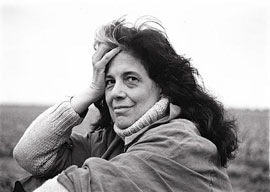
October 24, 2013

Susan Sontag
But her voice is in the grand tradition of reasoned discourse; therefore her work seeks to embody contradiction. The paradox of Against Interpretation is that it demolished barriers in defiance of its own title which signaled her fear of relativism, of muddy waters, of the tendency to say that X is really Y in order to prove Z. She’s also conscious, even in 1978, of the pitfall of surrendering high ground to any old trash:
But now because high culture is being liquidated, one wants to step backward, and say, Whoa, wait a minute, Shakespeare is still the greatest writer who ever lived, let’s not forget that.
She knew the risks of campaigning turning into bullying and worse:
…it was very clear that a lot of the activities of the New Left were very far from democratic socialism and were deeply anti-intellectual, which I think of as part of the fascist impulse.
One of her heroes, Gide, was on to that before World War II, but it’s amazing how challenging it still sounds, that totalitarianism wears many hats.
She is a courageous individualist:
I hate seeing myself as a victim…I want to feel as responsible as I possibly can.
And one of her most attractive characteristics is that she never apologizes for sounding highbrow”none of that groveling to a supposedly moronic mass”but she can hit with this sort of charm, too:
I”m much more ignorant than most people think. If you were to ask me to explain what structuralism or semiology mean, I couldn”t tell you….
Although she died in 2004 and didn”t live enough in the Internet age to develop distinct thoughts about it, she does prefigure some of its problems: “…a world in which everything is being recycled and recombined and things are being reduced to a common denominator….” However, her famous book On Photography (1977) now reads like an analysis of carpet-weaving. Technology has overtaken it.
Sontag may not be one of the great originals, but she is terrific at opening doors to the originality of others, and that makes her a beguiling and enduring teacher. Her tone is penetrating but never shrill and she is memorable on illness, literature, art, love, and sex (“I don”t think natural sexuality is available to any of us”), and overall this book serves up a delicious intellectual lunch.
But there are two points I”d particularly like to pick with her. In reference to the breakdown of her marriage and her divorce, she says she needed “long periods of chastity.” In fact after the divorce, she went immediately to live with a woman for six years. Her moment to come out is there, on page 109. Cott coaxes, and Sontag funks it. The other thing she misses is the renewed horror from religion. In 1978 it seemed that the civilized world had finally rid itself of religious mania and she is able in this interview to view religion nostalgically. This is perhaps the third quaint touch, for eleven years later the Rushdie Affair would initiate a whole new era of extreme religious violence against the freedoms, high and low, which she advanced.